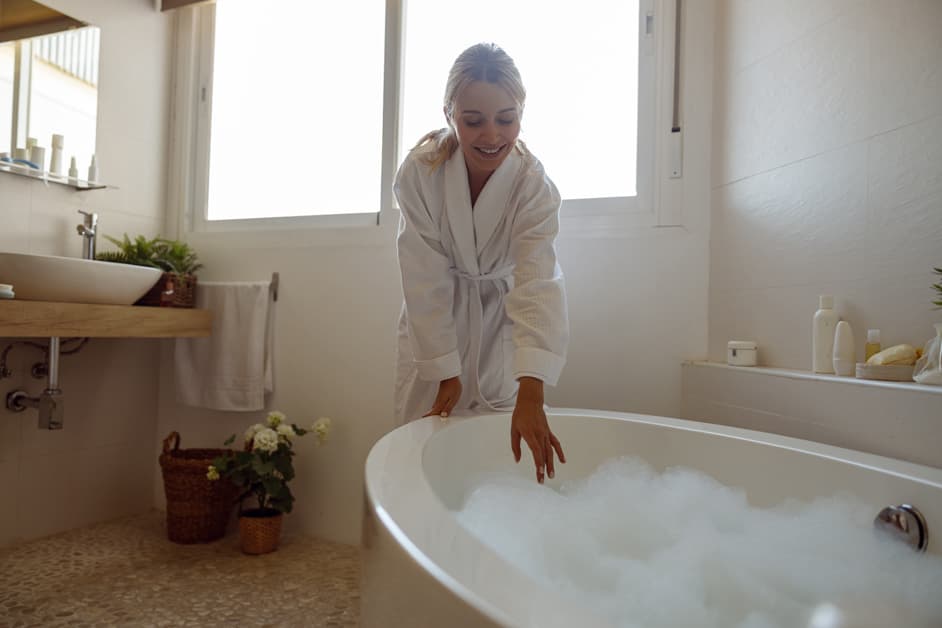Introduction
Knee pain is common among all ages, and can be caused by anything from wear and tear to disease. Heat and cold therapies are potential treatments to manage knee pain. Heat increases blood flow to the affected area and reduces discomfort, while cold therapy reduces inflammation. But, these therapies should only be used if there is no sign of infection.
Heat therapy can include
- hot baths
- heating pads
- paraffin wax treatments
- infrared lamps
- warm compresses
- electric blankets
Fifteen minutes, three times a day has been useful in decreasing swelling and discomfort.
Cold therapy includes
- cold packs
- ice massages
Cold packs should be refrigerated or frozen and applied for 15-20 minutes each time, up to 6 times a day. Ice massages should not be done more than once per day. Both heat and cold therapies offer benefits, but should be discussed with a doctor before use.
Benefits of Heat and Cold Therapy
Heat and Cold Therapy is a fantastic approach to managing knee discomfort caused by wear and tear. This therapy offers many advantages that can reduce the intensity of the knee pain. It boosts blood circulation, alleviates stiffness, reduces inflammation, and relaxes the muscles.
Let’s get an in-depth look at the advantages of Heat and Cold Therapy for knee pain management due to wear and tear:
Improved circulation
Heat and cold applied correctly can help reduce knee pain. Heat therapy boosts circulation, leading to faster healing and less stiffness. Hot packs, electric heating pads or warm towels should be used for around 15-20 mins, but don’t fall asleep with them. Cold therapy reduces inflammation. Ice packs, gel packs or frozen veggies in a towel can be used for 10-15 minutes.
Reduced inflammation
Heat therapy boosts blood flow to the sore area, providing oxygen and other nutrients that can help decrease inflammation. Plus, it causes the release of endorphins, which block pain signals from entering the brain. It’s great for muscle stiffness or tension due to weather changes and age-related ailments such as arthritis.
Cold therapy is amazing for soothing inflammation in knee joints. Also, it numbs pain from wear and tear on the knees. An ice pack or compress can provide temporary relief from aching knuckles or arthritic joints. It’s useful for relieving stiff muscles around the area caused by such activities as walking, running or playing sports.
Pain relief
Heat and cold therapies can both help reduce pain and improve mobility. Heat dilates blood vessels, allowing oxygen and nutrients to reach the injury. This increased circulation can help relax stiff muscles and reduce pain. Heat also stimulates endorphins, natural painkillers.
Cold therapy works by constricting vessels and stopping inflammation. Cold is most effective in the first 48 hours post injury. It decreases swelling and numbs sore areas, while relieving pain. The combination of cold therapy and anti-inflammatory medication can reduce recovery time.
For optimal relief from knee injuries due to wear and tear, it’s important to understand how heat and cold therapies can work together. When used correctly, these two therapies can be combined for maximum benefit!
Heat Therapy
Heat therapy can help with knee pain due to wear and tear. It increases blood circulation which encourages healing of the muscles and soft tissue surrounding the joint. It also provides temporary relief from the pain.
Heat therapy can be applied in many ways, such as:
- Ice packs
- Hot water bottles
- Moist heat
- Heating pads
- Infrared light
Knowing the right way to use heat and cold therapy will help you manage your knee pain well.
Types of Heat Therapy
Heat therapy is a type of physical therapy. It can help relieve pain and promote healing and flexibility. Several forms of heat therapy exist, such as compresses, baths, wraps, and infrared light. Heat therapy works by stimulating circulation and relaxing muscles.
Common types of heat therapy:
- Hot water bottles. Fill these with hot water and place on the affected area.
- Electric heating pads. Fasten these flexible pads around joints for warmth. They come in various sizes and levels of warmth.
- Heating cream. Apply directly to skin. Gently heat before use for deep warmth.
- Infrared heat lamps. Use infrared radiation to increase blood flow, improve joint mobility, and decrease inflammation.
- Saunas/steam shawls/hot wraps. Wraps stay heated for a certain amount of time after being applied directly or worn as a shawl. They help ease pain in joints.
How to Apply Heat Therapy
Heat therapy is a popular treatment for knee pain due to wear and tear. It increases circulation, relaxes stiff muscles, relieves muscle spasms and reduces inflammation. Heat should be applied for 15-20 minutes, every 2-3 hours.
There are several options to choose from, such as hot bag, hot water bottle, warm bath or shower. Wrap-around heating pads with Velcro straps can be found online or in pharmacies. It’s important to not apply heat directly onto the skin. Put a layer of cloth between the skin and the heating pad for extra safety. Experiment with different temperatures until you find what works best for you. Always stay at ‘medium’ settings if using electricity-powered devices. Do not leave any form of hot therapy on while sleeping, as it could result in serious injury.
Cold Therapy
Cold therapy is great for knee joint pain! It works by reducing inflammation, decreasing inflammatory molecules and increasing blood flow. This helps relieve pain and stiffness.
Now let’s learn about the benefits of cold therapy and how to use it correctly!
Types of Cold Therapy
Cold therapy, known as cryotherapy, is often used to treat knee pain and inflammation caused by degenerative conditions such as arthritis. Treatments may include cold packs, compresses or ice massages to reduce inflammation and nerve conduction by lowering the temperature around the area.
When treating knee pain due to wear and tear, two types of cold therapy exist: static and dynamic.
- Static therapy involves placing a pre-chilled pack or device over the affected area for up to 20 minutes, repeated throughout the day.
- Dynamic cold therapy uses adjustable wraps, such as pneumatic ice bags or cooling gel bead wraps. These wraps provide cooling and pressure/support to the joint. Some systems offer 16 levels of intensity, however the highest setting isn’t always the most effective.
How to Apply Cold Therapy
Cold therapy is a good way to manage knee pain from wear and tear. Follow these steps for safe use:
- Clean your hands before use to avoid infections.
- Put ice cubes or gel packs in a cloth wrap (3 times) so you don’t have to touch cold packaging with your skin.
- Position your knee in a comfortable position (while lying down or standing) so that the cold pressure is secure on the injured or inflamed area.
- Place the ice/gel pack evenly across your skin – but don’t apply too much pressure.
- Check for changes like tingling, redness, discoloration, or increased pain – if any of these happen, tell your doctor.
- Keep track of how long you apply cold therapy each time – usually short sessions are better than just one long one. Gradually reduce exposure when you’re done.
Safety Considerations
Before using heat or cold therapy, it is important to consider any safety implications. Familiarize yourself with the methods of application and any potential risks associated.
Heat Therapy
- When using heat therapy, extra precautions should be taken to avoid overheating the area or making contact with open wounds. A cloth towel can be used as a protective layer between the skin and a hot surface. Heating pads should be monitored to prevent burning. It is also recommended to record the temperature of heated surfaces before applying to extremities.
Cold Therapy (also known as cryotherapy or ice therapy)
- Cold therapy is best for inflammation. It should not be placed on open wounds. Water-safe items such as gel packs or frozen vegetables in zip-lock bags should be frozen to avoid contact with any dangerous microorganisms from sewage.
- Cryotherapy should not be used for more than 20 minutes at a time to avoid damaging healthy tissue near application site. If there is a pins and needles sensation during treatment, it should be stopped until the issue subsides to avoid permanent tissue damage.
With proper care and corrective measures, knee pain can be relieved and a full recovery is possible. After a few weeks, a total success story can be achieved, as the individual will regain their maximal physical condition and former capabilities. With minimal effort and care, impressive results and productivity can be achieved. Enjoy lasting peace of mind with extreme satisfaction.
Conclusion
To wrap it up, using both heat and cold therapies to treat knee pain due to degenerative joint conditions is common. This can not only provide temporary relief, but can help increase the range of motion and reduce muscle tension.
Nonetheless, consulting your doctor or physical therapist before trying out a new treatment is the wisest move. In the end, targeting the root of the issue is the only way to ensure long-term success for wear and tear knee pain.
Frequently Asked Questions
Q1: What are the benefits of using heat and cold therapy for knee pain caused by wear and tear?
A1:Heat and cold therapy can help reduce pain and swelling caused by wear and tear on the knee joint. Heat therapy can increase blood flow and help relax muscles, while cold therapy can reduce inflammation and numb the area. Both treatments can be used together to provide relief from knee pain.
Q2: How often should I use heat and cold therapy on my knee?
A2: The amount of time and frequency of using heat and cold therapy will depend on the severity of your knee pain. If you are using heat therapy, it is recommended to use it for a maximum of 20 minutes at a time. For cold therapy, it is best to use it for no more than 15 minutes at a time. It is best to consult your doctor or physical therapist to get specific instructions for your condition.
Q3: Are there any precautions I should take when using heat and cold therapy on my knee?
A3: It is important to use caution when using heat and cold therapy on your knee. Be sure to check with your doctor or physical therapist to ensure that it is safe for you to use. Make sure to follow the instructions given and do not apply heat or cold for more than the recommended amount of time. Also, make sure to keep the area clean and dry before and after each treatment.





